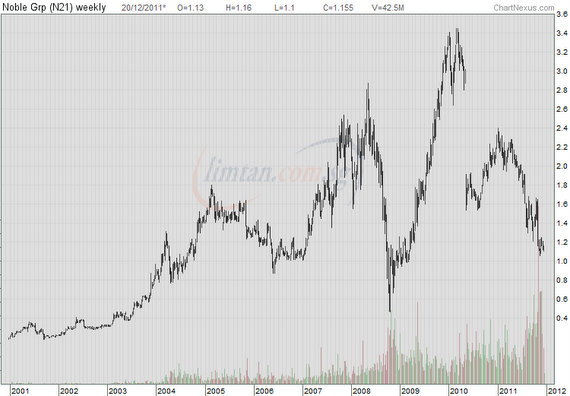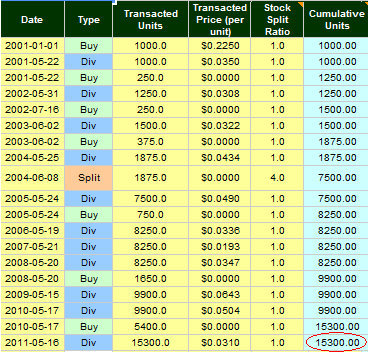The following content was recently published on Drizzt's blog, www.investmentmoats.com, and is reproduced with permission.

I recently did a short exercise with some of the stocks listed on the Singapore Stock Exchange. I wanted to see how dividends, splits, rights and bonus shares affected them.
So I created a Google Spreadsheet to keep track of some stocks [You can review them here >>]
I covered a wide range of stocks -- from dividend stocks with predictable cash flow like Starhub, CMPacific, SMRT, First REIT to blue chip stalwarts like Keppel Corp, DBS, SIA Engg to the really small value stocks like Boustead, Kian Ann, Adampak.
While doing the exercise, one of the stocks that caught my attention was Noble Group.

Above is a chart of Noble’s stock price movement since 2001 when it was at 22.5 cents. During the 2001- 2003 bear market, Noble went through some great growth.
However, it went through another major bear market in 2007-2008 where it dropped from $2.80 to $0.40 again. Recently, the stock traded at $1.15.
Looking at the price chart, you would think that this stock is better for trading than investing in. If you had sold it at the high of $2.40 or $3.20 you would have gotten a really good deal.
Does that mean it's not good to buy and hold?
Which is where my spreadsheet comes in. Basically, I simulated what would happen if you bought 1000 shares of Noble at the start of 2001 and what your returns are like.
The result? If you kept Noble since 2001 at a cost of $225, your dividends would be $2,903 and your unrealized gains would be $18,517. The total return is approximately 9,520% which is made up of 8,230% unrealized capital gains and 1,290% dividend gains.

Why was there such a great gain?
Firstly, Noble since 2001 have had 6 bonus issues. Bonus issues typically do nothing much. Instead of paying out a cash dividend, a company like Noble pays you stock dividend.
Does your average share of the company increase? Not necessarily, the pool of money to pay out as dividends is kept within Noble so that the company can reinvest it to make you more money.
Since this pool is divided equally among all shareholders by increasing everyone’s share of the company, your share of the pie stays the same, but you get more shares.
Noble also had one stock split in 2004 whereby one share became 4 shares. This did nothing on its own as well. Stock splits just mean that instead of having 1000 shares at $4, you have 4000 shares at $1. The rationale is to make the price of each share look lower so that people are more attracted to it.
The magic comes about when Noble makes more money down the road. Your bonus shares that were issued to you these 10 years entitle you to more of the company’s return.
So instead of getting $1000 for each $1 earnings per share if you have 1000 shares, you would get $15300 for each $1 earnings per share because now after all the splits and bonus shares you have 15300 shares.
What we can learn from this:
- You can only gain this kind of astronomical return if you invest in a company that generates increasing profits. The bonus shares and splits are not magic. Having more shares when profits are falling or for the matter turning into losses would just make your stock a bad investment. The business, economics and operation matter if you want to hold a company for long.
- Bonus shares and good dividends appear to be indicative of management that has confidence in their business and prefers that you stick with them. In my brief exercise, not many would carry out a bonus share issue. Strangely those that issued bonus shares turned out to be rather sturdy companies that grow.
- The price you buy matters but it is important to know the value you get. Which is why we keep advocating buying 50 cents for $1 worth. Buy value at reasonable prices. Comparing 2 commodities investments then, you may get more value simply because Noble choose to reward their shareholders more.
- I tried changing the first buy price of Noble from 22.5 cents to $3 or $6 and turns out you would still make money! You only start losing money if you have bought Noble at $22 in 2001. That to me is pretty amazing.
- Compounding and the time value of money will work if you spot a company that grows its earnings and reward you.
- Reinvest only in companies with good business, sound management that consistently shows a willingness to reward share holders. Management retires and business environment changes. Noble is in a stage right now where the chairman is struggling to find a successor. We are entering another difficult operation condition. Your dividends will ensure that you receive rewards while waiting. A change from the policy these 10 years (cutting bonus issue and dividend policy) would signal that you need to relook your investment.
-
Hindsight is a bitch. This exercise just shows I missed a great deal.
By day, Drizzt is a software and system support specialist. By night, he shares his escapades in money management, investing and his love for all things technology. Drizzt holds a degree in Computer Science from the National University of Singapore and is certified at many levels in systems and software competency.







